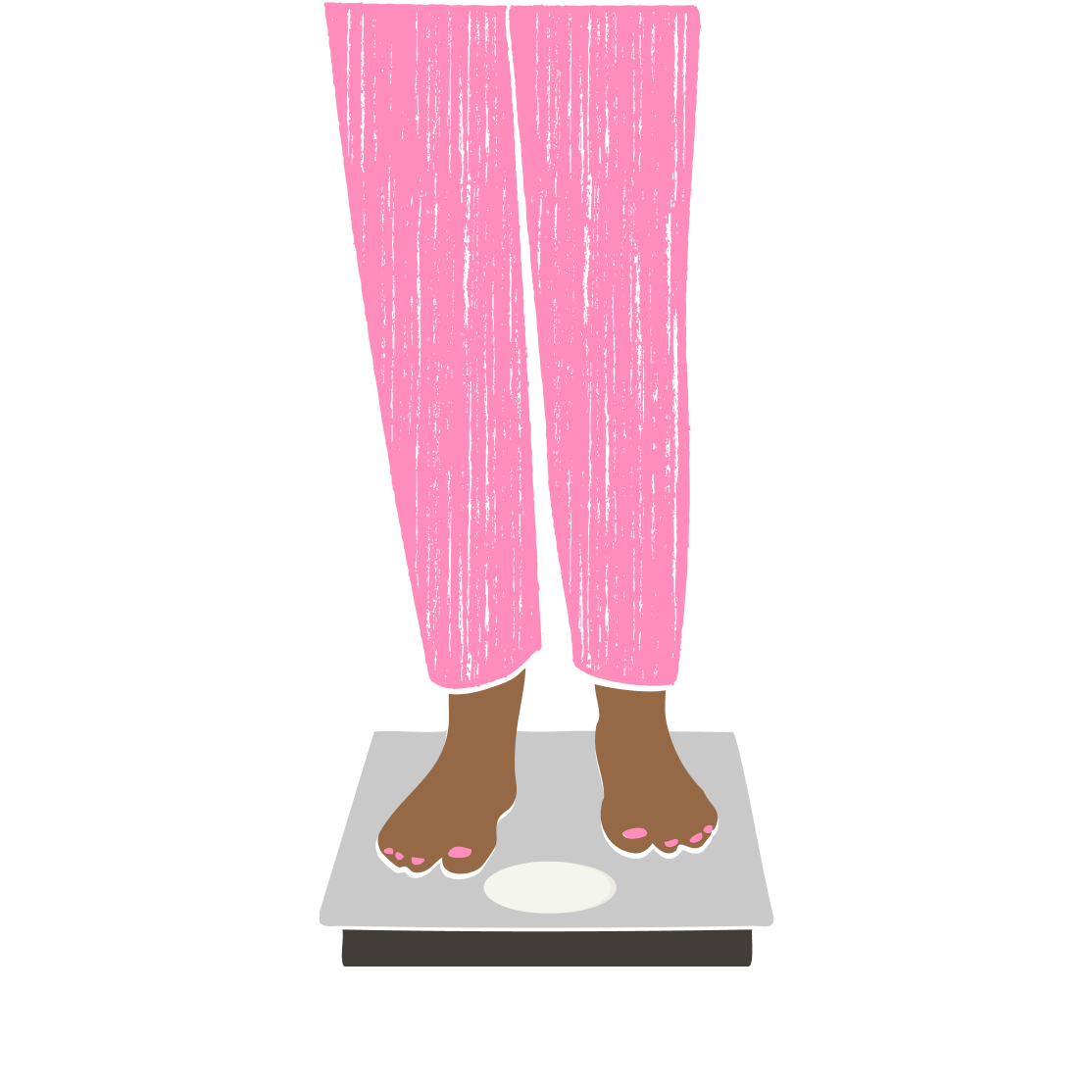Spotting is a common—and often surprising—part of the perimenopause journey. During this transition, fluctuating estrogen levels can lead to irregular bleeding, from light spotting to heavier-than-usual periods. While most spotting is related to hormonal shifts, it can sometimes signal underlying conditions like PCOS, fibroids, or thyroid issues. If you’re noticing unusual bleeding patterns, tracking your symptoms and consulting a menopause specialist, like those at Midi, can provide clarity and personalized solutions. Keep reading to learn why spotting happens, what’s normal, and when it’s time to seek medical care.
The menopause transition marks the end of your reproductive years, which should mean no more periods, right? No more buying pads or tampons, no more PMS, no more wrecking your favorite underwear. That sounds like great news, but while we hate to be a downer, we’ve got an update that may surprise you: It’s perfectly normal to experience irregular cycles and even spotting throughout the menopausal transition, known as perimenopause.
Sometimes, though, spotting can be related to underlying health issues that require medical attention. If you have a history of thyroid problems or PCOS, for example, spotting could indicate an issue related to those conditions.
But if you’re someone who’s always experienced periods like clockwork, mid-cycle spotting can be annoying and stressful. Working with a healthcare provider can help you make sense of what’s going on. Midi clinicians are trained menopause specialists who understand the “why” behind menopausal body changes, and can offer a range of solutions, including prescription medications, supplements and botanicals, and lifestyle coaching.
One thing to note before you read on: Menopause is defined as a point in time, not a stage, and it occurs when you’ve gone 12 months without a period. What happens before that time, when your hormone levels start to decline but you still get periods, is perimenopause, and what comes after the 12-month-mark is post-menopause. So talking about symptoms experienced “during menopause” really refers to perimenopause. Why does this matter? Certain symptoms you experience at different points during this transition can warrant distinct treatments and warnings, so we want you to be clear on what you should watch out for when. Spotting or any bleeding after menopause, when you’ve gone one full year without a period, is not common, so you’ll want to see a healthcare provider for more evaluation.
Now let’s learn more about why you may experience spotting during perimenopause, how to prepare for it, and when to consult a healthcare provider or Midi clinician about your symptoms.
Understanding Perimenopause and Menstrual Changes
Before we get into spotting during menopause, we first need to break down the difference between perimenopause and menopause. It’s important to distinguish between the two because it will impact how you think about any spotting you experience.
What is Perimenopause?
Again, perimenopause is the phase leading up to menopause. Generally, it begins in your mid-40s and can last anywhere from four to 10 years, but these timelines are highly variable. How perimenopause feels, when it starts, and how long it lasts varies enormously from one woman to the next. Some may start seeing signs of perimenopause before age 40 and others after 50. Some of us experience perimenopause for a few months; for others, it can go on for 10 years.
During perimenopause, your body is gearing up to stop ovulating each month, leading to a decline in the production of estrogen and progesterone. But it’s not a linear downward slope. Instead, these hormones can fluctuate wildly during their descent, causing a range of symptoms—hot flashes, night sweats, insomnia, brain fog, changes in your body scent, hair and skin changes, moodiness, weight gain, and yes, erratic periods—as your body scrambles to adapt until you reach menopause. As stated above, menopause is a point in time, not a stage, and it occurs when you’ve gone 12 months without a period.
Menstrual Irregularities in Perimenopause
As your body begins its march towards menopause, your periods will become more irregular until they eventually stop. But this doesn’t necessarily mean that your periods will become shorter, lighter, and further apart—in fact, 78 percent of women experience longer and heavier periods during perimenopause.
There is a wide range of “normal” during this time. The stretch between periods can be longer one month, shorter the next, and flow can be heavier, then suddenly lighter. Your period may go missing entirely for months, then come roaring back. If estrogen is spiking up between cycles, the uterine lining will be thicker and your period, in turn, will tend to be heavier. When estrogen drops low, there’s less buildup of the uterine lining, so periods will tend to be lighter (more like spotting).
This can be a confusing time, but there’s no reason you have to struggle through it on your own. Book a virtual visit with a menopause specialist through a platform like Midi. Your clinician can analyze your menstrual patterns and give you personalized recommendations based on your symptoms and health history.
What Causes Spotting During Perimenopause?
As your body adjusts to the hormonal rollercoaster of perimenopause, you may experience spotting between periods or spotting before an actual period begins.
Before perimenopause, estrogen and progesterone levels usually follow a predictable, cyclical pattern. Roughly every 28 to 32 days, they’ll signal to the uterus that it’s time to let the lining go, thus kicking off your monthly period.
When your estrogen levels are in a constant state of flux (rising and falling daily) during perimenopause, your hormones can send mixed signals to your reproductive system about when it’s time to shed its uterine lining. This can lead to spotting for a few reasons: Your uterus may not shed all its lining during your monthly period, it may create and shed lining at the wrong time, or otherwise react irregularly.
Medical Conditions That May Cause Spotting
There is a possibility that your spotting is not caused by perimenopause or menopause. If you have a history of these conditions and experience consistent spotting, contact a doctor to receive personalized guidance.
Endometriosis
Endometriosis is a condition where the tissue lining the uterus (endometrium) grows outside the uterus. The displaced endometrial tissue can cause inflammation, scarring, and irregular bleeding as it responds to hormonal changes. If spotting is accompanied by pelvic pain, painful periods, or discomfort during intercourse, it could be a sign you have endometriosis.
Polycystic Ovarian Syndrome (PCOS)
PCOS is a hormonal disorder in which your ovaries are enlarged and prone to developing cysts. Hormonal imbalances, particularly elevated androgen levels, can disrupt the normal menstrual cycle and cause irregular bleeding. If other symptoms like acne or excessive hair growth are present, talk to your doctor about PCOS.
Uterine Polyps
Endometrial polyps, or uterine polyps, are growths in the uterus that most commonly appear in perimenopausal and menopausal women. Though usually benign, polyps can alter the uterine environment, leading to irregular bleeding or spotting. Contact a healthcare professional if spotting is recurrent or if you have abnormal amounts of pelvic pain while spotting.
Fibroids
Uterine fibroids are non-cancerous growths in the uterus, made of muscle cells and connective tissue (as opposed to polyps, which are made of endometrial tissue). Fibroids can disrupt the uterine lining, leading to changes in menstrual flow and occasional spotting. If spotting is accompanied by heavy or prolonged periods, pelvic pain, or frequent urination, you may have fibroids which can be detected with an ultrasound.
Vaginal Dryness
Vaginal dryness is a common symptom among women in perimenopause and menopause, as the reduction of estrogen leads to the thinning of your vaginal tissue. This can lead to irritation and microtears in the vagina, which cause small amounts of bleeding you might mistake for spotting. Don’t hesitate to talk to your healthcare provider about irritation or discomfort in and around your vagina—there are many paths to relief.
Cancer
Spotting after menopause, once you’ve gone a full year without a period, may be a warning sign of endometrial cancer. In fact, roughly 9 percent of post-menopausal women who report vaginal bleeding are diagnosed with endometrial cancer, according to research. If you notice any bleeding after a year without your period, talk to your doctor immediately.
Hypothyroidism
Your thyroid is a small, butterfly-shaped gland located in the front of your neck. Hormones produced by the thyroid play a role in every part of your body at every stage of life, including menopause. These hormones travel to other organs and tissues in your body to regulate metabolism, digestion, heart rate, body temperature, brain development, and even your menstrual cycle.
Hypothyroidism, in which your thyroid doesn’t produce enough of its hormones, can throw your monthly cycle off, causing irregular bleeding.

Is It Normal to Spot Old Blood During Perimenopause?
The color of your period blood indicates how old it is. If the blood on your pad or tampon is bright red, that endometrial fluid is relatively new; dark, brick red, or brownish indicates the fluid is older and more oxidized.
Because your uterus is shedding its lining irregularly, it may accumulate more lining over time, leading to that brown or brick-red color. But if you regularly see brown or dark discharge, let your healthcare provider know. Brown discharge can point to multiple root causes, such as endometrial hyperplasia (a precancerous condition in which there is an irregular thickening of the uterine lining that may lead to endometrial cancer if left untreated) or an infection. If your spotting is accompanied by deep discomfort, itching around your vagina, or pain, it’s time to seek medical attention.
No matter what symptoms accompany your spotting, it can be a good idea to track your menstrual patterns in an app or on a calendar so you can spot irregularities and share them with your healthcare provider. A Midi clinician can provide guidance on managing your symptoms and addressing concerns about old blood.
Does Light Spotting Count as a Period During Perimenopause?
With all the changes to your flow and frequency, you may wonder what qualifies as an actual period anymore. If you’re spotting for 10 days straight, does that count as a period? What about a single day of heavy blood?
Most providers use three essential criteria to determine whether something counts as spotting or a full period: cycle consistency, flow, and duration of bleeding. If you’re bleeding at consistent intervals for three to five days at a time, those are likely still late-stage perimenopause periods even if it looks more like spotting.
How Many Days Does Menopause Spotting Last?
Spotting during perimenopause can be hard to define. What one woman considers unusual spotting might be a normal light period to another. Usually, spotting is random and unpredictable. However, if you’re experiencing spotting daily for more than a week, it may be a sign of a condition that needs attention.
That’s why it’s important to consult with your healthcare provider to determine if you are experiencing prolonged spotting as a result of perimenopause or if your symptoms require further examination.
When to Seek Medical Advice for Spotting in Menopause
According to a recent survey, 73% of women in menopause are not seeking treatment for their symptoms during the menopause transition. There’s a common misconception that menopause symptoms are natural, so you simply have to gut them out, but we strongly disagree. At Midi, we know how positive a woman's menopause experience can be when she works with a healthcare provider who takes her symptoms seriously. And getting early care for your menopause symptoms can ensure that you and your provider tackle any potential problems before they get worse so you get the relief you deserve.
Recognizing Warning Signs
Some spotting warrants an immediate phone call to a trusted healthcare provider. These include:
- Sudden and unexpected vaginal bleeding
- Sharp pains in your abdomen accompanied by bleeding or spotting
- Discharge with a strong or unpleasant odor
Any of these symptoms could point to an underlying condition that could become serious.
Though irregular bleeding is common in perimenopause due to inconsistent ovulation, frequent irregular bleeding or spotting needs to be evaluated to rule out endometrial hyperplasia or cancer. If you’re experiencing periods more than twice a month for more than a few months or have a bleed-stop-bleed-stop pattern, let your healthcare provider know.
Potential Solutions For Spotting During The Menopause Transition
Luckily, there are many potential treatments for your menopause symptoms out there. Your doctor may recommend lifestyle changes, such as eliminating processed foods from your diet or exercising for 30 minutes a day, and other shifts in your routine that support weight management. A well-rounded approach to wellness during menopause is often the most effective for long-term results.
They may also prescribe a medication for your symptoms — such as hormonal therapy (which can include hormonal birth control methods, hormone replacement therapy, or a combination of both). If you utilize HRT during the menopause transition, you will take estrogen supplements either orally or topically to mitigate the symptoms most directly linked to the estrogen drop. You’re most likely to have HRT prescribed if you are experiencing multiple hormone-related symptoms, such as night sweats, hot flashes, irregular periods, and vaginal dryness.
Above all, be honest with your healthcare provider during this time. Communicate all of your symptoms, and don’t underplay their severity. You deserve to have a comfortable menopause journey!
Can Hormone Therapy Cause Spotting?
If you’ve started a regimen of HRT to help with menopausal symptoms, it’s very common in the first one to three months to have some bleeding. Usually, patients experience light spotting if they are fully menopausal (reminder, that’s after a year with no periods), but bleeding can be heavier or more frequent for those in perimenopause and still having periods. This is generally nothing to be concerned about, but you’ll want to discuss it with your provider or Midi clinician, which should be scheduled a month or so after starting HRT.
Spotting or bleeding happens because hormones you’re taking may stimulate the uterine lining, which sheds a little bit, like a period. As your body adjusts to your medications, the bleeding should go away. If it does not, adjusting your prescription will usually take care of it.
Very heavy bleeding that doesn’t stop is much more unusual, and needs immediate medical attention. If you are soaking through a pad or tampon every hour you should head to an ER or urgent care to be evaluated, especially if you also feel lightheaded.

The Takeaway
- Hormonal fluctuations during perimenopause can cause irregular cycles, spotting, or heavier periods.
- Spotting may also result from conditions like PCOS, fibroids, endometriosis, or hypothyroidism and requires medical attention if it occurs after menopause.
- Tracking your symptoms helps healthcare providers identify causes and recommend personalized treatments.
- Menopause specialists can offer solutions like medications, supplements, and lifestyle changes to manage symptoms effectively.
- Prolonged or unusual spotting should not be ignored, as it may indicate underlying issues that need evaluation.
If you’re in perimenopause or menopause and want guidance from clinicians who specialize in women’s midlife health, book a virtual visit with Midi today.
Hormonal change is at the root of dozens of symptoms women experience in the years before and after their period stops.
Our trained menopause specialists can help you connect the dots to guide you towards safe, effective solutions.
Whether you need personalized guidance or a prescription routine to tackle symptoms—including brain fog, hot flashes, sleep trouble, mood swings, and weight gain—we’ve got you covered.
FAQs About Spotting During Perimenopause and Menopause
Is spotting a normal part of the menopause transition?
Yes, spotting can be a regular part of perimenopause due to hormonal changes, but it's essential to monitor the frequency and amount of spotting.
What causes spotting during perimenopause?
Spotting during perimenopause is primarily caused by hormonal fluctuations, with declining levels of estrogen and progesterone leading to irregular bleeding.
Can perimenopause cause changes in menstrual flow?
Perimenopause can significantly change menstrual flow, leading to both heavier and lighter periods.
How long does spotting during menopause typically last?
The duration of spotting during perimenopause varies from person to person, but often lasts a few days to a week; persistent or heavy spotting should be discussed with a healthcare provider. You shouldn’t spot after menopause.
Should I be concerned about spotting old blood during perimenopause?
Spotting old blood—which is darker in color—during perimenopause (the years leading up to full menopause) is usually not a cause for concern, and is often due to slower shedding of the uterine lining. Still, frequent spotting or accompanying symptoms should be medically evaluated.
Does spotting mean I am entering menopause?
Spotting can be an early sign of perimenopause, the transitional phase leading to menopause, but it's not a definitive indicator. Other symptoms and factors should be considered.
How can I manage spotting during menopause?
Some women find relief through hormone therapy or other treatments prescribed by their doctor. Spotting after menopause, when a full year has passed with no periods, may be a warning sign of cancer and should be evaluated by a doctor.
When should I see a doctor about perimenopause spotting?
If spotting is heavy, accompanied by pain, or if you experience any other concerning symptoms, reach out to a healthcare provider immediately. Even if spotting isn’t painful, it’s still a good idea to let your healthcare provider know—you don’t have to manage symptoms on your own.
Can hormonal therapy help with spotting during perimenopause?
Hormonal therapy can help regulate menopause spotting for some women by balancing hormone levels, but discussing the benefits and risks with a healthcare provider is essential.
Are there any risk factors that increase the likelihood of spotting during menopause?
Risk factors for increased spotting during perimenopause include a history of hormonal imbalances, certain conditions like fibroids, PCOS, or hypothyroidism, and lifestyle factors such as excessive stress. Regular check-ups can help in managing these risks.
Midi’s mission is to revolutionize healthcare for women at midlife, wherever they live and whatever their health story. We believe that starts with education, to help all of us understand our always-changing bodies and health needs. Our core values guide everything we do, including standards that ensure the quality and trustworthiness of our content and editorial processes. We’re committed to providing information that is up-to-date, accurate, and relies on evidence-based research and peer-reviewed journals. For more details on our editorial process, see here.
 Tabitha Wilson
Tabitha Wilson



